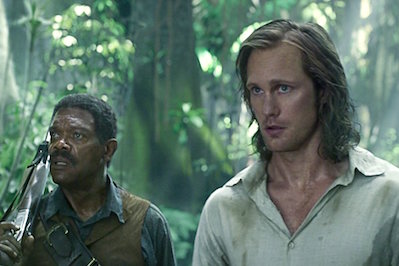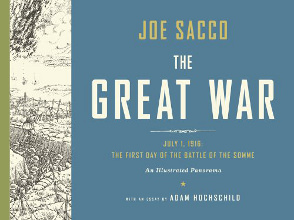Letting Tarzan Swing Through History
Tarzan’s remarkable foresight in vanquishing the Belgian evildoers before the worst of King Leopold II's reign of terror opens the door for his future films, where our hero stops historical catastrophes in their early stages. Samuel L. Jackson and Alexander Skarsgård in "The Legend of Tarzan." (Warner Bros.)
1
2
Samuel L. Jackson and Alexander Skarsgård in "The Legend of Tarzan." (Warner Bros.)
1
2

Samuel L. Jackson and Alexander Skarsgård in “The Legend of Tarzan.” (Warner Bros.)
Some time ago I wrote a book about one of the great crimes of the last 150 years: the conquest and exploitation of the Congo by King Leopold II of Belgium. When King Leopold’s Ghost: A Story of Greed, Terror and Heroism in Colonial Africa was published, I thought I had found all the major characters in that brutal patch of history. But a few weeks ago I realized that I had left one out: Tarzan.
Let me explain. Although a documentary film based on my book did appear, I often imagined what Hollywood might do with such a story. It would, of course, have featured the avaricious King Leopold, who imposed a slave labor system on his colony to extract its vast wealth in ivory and wild rubber, with millions dying in the process. And it would surely have included the remarkable array of heroic figures who resisted or exposed his misdeeds. Among them were African rebel leaders like Chief Mulume Niama, who fought to the death trying to preserve the independence of his Sanga people; an Irishman, Roger Casement, whose exposure to the Congo made him realize that his own country was an exploited colony and who was later hanged by the British; two black Americans who courageously managed to get information to the outside world; and the Nigerian-born Hezekiah Andrew Shanu, a small businessman who secretly leaked documents to a British journalist and was hounded to death for doing so. Into the middle of this horror show, traveling up the Congo River as a steamboat officer in training, came a young seaman profoundly shocked by what he saw. When he finally got his impressions onto the page, he would produce the most widely read short novel in English, Heart of Darkness.
How could all of this not make a great film?
I found myself thinking about how to structure it and which actors might play what roles. Perhaps the filmmakers would offer me a bit part. At the very least, they would undoubtedly seek my advice. And so I pictured myself on location with the cast, a voice for good politics and historical accuracy, correcting a detail here, adding another there, making sure the film didn’t stint in evoking the full brutality of that era. The movie, I was certain, would make viewers in multiplexes across the world realize at last that colonialism in Africa deserved to be ranked with Nazism and Soviet communism as one of the great totalitarian systems of modern times.
In case you hadn’t noticed, that film has yet to be made. And so imagine my surprise, when, a few weeks ago, in a theater in a giant mall, I encountered two characters I had written about in King Leopold’s Ghost. And who was onscreen with them? A veteran of nearly a century of movies — silent and talking, in black and white as well as color, animated as well as live action (not to speak of TV shows and video games): Tarzan.
The Legend of Tarzan, an attempt to jumpstart that ancient, creaking franchise for the twenty-first century, has made the most modest of bows to changing times by inserting a little more politics and history than dozens of the ape man’s previous adventures found necessary. It starts by informing us that, at the Berlin Conference of 1884-1885, the European powers began dividing up the colonial spoils of Africa, and that King Leopold II now holds the Congo as his privately owned colony.
Tarzan, however, is no longer in the jungle where he was born and where, after his parents’ early deaths, he was raised by apes. Instead, married to Jane, he has taken over his ancestral title, Lord Greystoke, and has occupied his palatial manor in England. (Somewhere along the line he evidently took a crash course that brought him from “Me Tarzan, you Jane” to the manners and speech of a proper earl.)
But you won’t be surprised to learn that Africa needs him badly. There’s a diamond scandal, a slave labor system, and other skullduggery afoot in Leopold’s Congo. A bold, sassy black American, George Washington Williams, persuades him to head back to the continent to investigate, and comes along as his sidekick. The villain of the story, Leopold’s top dog in the Congo, scheming to steal those African diamonds, is Belgian Captain Léon Rom, who promptly kidnaps Tarzan and Jane. And from there the plot only thickens, even if it never deepens. Gorillas and crocodiles, cliff-leaping, heroic rescues, battles with man and beast abound, and in the movie’s grand finale, Tarzan uses his friends, the lions, to mobilize thousands of wildebeest to storm out of the jungle and wreak havoc on the colony’s capital, Boma.
With Jane watching admiringly, Tarzan and Williams then sink the steamboat on which the evil Rom is trying to spirit the diamonds away, while thousands of Africans lining the hills wave their spears and cheer their white savior. Tarzan and Jane soon have a baby, and seem destined to live happily ever after — at least until The Legend of Tarzan II comes along.
History Provides the Characters, Tarzan the Vines
Both Williams and Rom were, in fact, perfectly real people and, although I wasn’t the first to notice them, it’s clear enough where Hollywood’s scriptwriters found them. There’s even a photo of Alexander Skarsgård, the muscular Swede who plays Tarzan, with a copy of King Leopold’s Ghost in hand. Samuel L. Jackson, who plays Williams with considerable brio, has told the press that the director, David Yates, sent him the book in preparation for his role.
A version of Batman in Africa was not quite the film I previewed so many times in my fantasies. Yet I have to admit that, despite the context, it was strangely satisfying to see those two historical figures brought more or less to life onscreen, even if to prop up the vine swinger created by novelist Edgar Rice Burroughs and played most famously by Johnny Weissmuller. Williams, in particular, was a remarkable man. An American Civil War veteran, lawyer, journalist, historian, Baptist minister, and the first black member of the Ohio state legislature, he went to Africa expecting to find, in the benevolent colony that King Leopold II advertised to the world, a place where his fellow black Americans could get the skilled jobs denied them at home. Instead he discovered what he called “the Siberia of the African Continent” — a hellhole of racism, land theft, and a spreading slave labor system enforced by the whip, gun, and chains.
From the Congo, he wrote an extraordinary “open letter” to Leopold, published in European and American newspapers and quoted briefly at the end of the movie. It was the first comprehensive exposé of a colony that would soon become the subject of a worldwide human rights campaign. Sadly, he died of tuberculosis on his way home from Africa before he could write the Congo book for which he had gathered so much material. As New York Times film critic Manohla Dargis observed, “Williams deserves a grand cinematic adventure of his own.”
Your support matters…Independent journalism is under threat and overshadowed by heavily funded mainstream media.
You can help level the playing field. Become a member.
Your tax-deductible contribution keeps us digging beneath the headlines to give you thought-provoking, investigative reporting and analysis that unearths what's really happening- without compromise.
Give today to support our courageous, independent journalists.







You need to be a supporter to comment.
There are currently no responses to this article.
Be the first to respond.